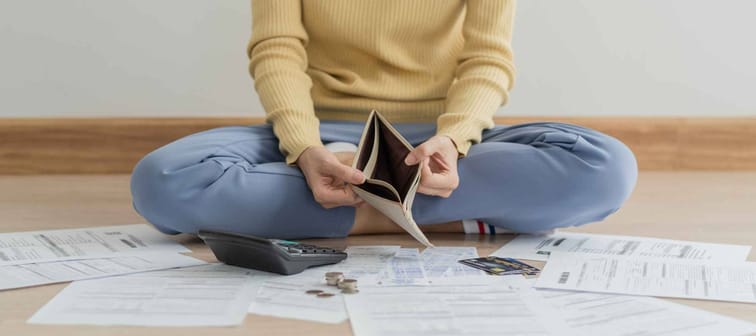1. Open a new chequing and savings account
Opening new chequing and savings accounts can help recently bankrupted individuals start off on the right foot and begin sound, long-term financial planning. The right account(s) should minimize monthly banking fees and generate meaningful levels of interest on earnings.
A simple, practical chequing account that we recommend is the Basic Bank Account from Scotiabank. Price-wise, its monthly fee of $3.95 is comparable to other chequing account options, and like other options, it gives customers with nominal banking needs a way to pay bills automatically and engage in up to 12 free transactions per month1.
Scotiabank has a practical Scotiabank Savings account for post-bankruptcy customers, as well. The Momentum Plus Savings Account incentivizes financial discipline while simultaneously building up savings
Read more: Best Scotiabank chequing accounts
Conditions apply. Visit here to learn more.
2. Make a habit of paying all bills on time
Erasing debt through bankruptcy unfortunately won’t permanently stop bills from coming your way, and after filing for bankruptcy it becomes even more important to pay incoming bills promptly. By organizing and tracking all regular expenses like utilities, internet, and phone bills, customers can pay their obligations on time and rebuild credit. This will not reflect on a credit score immediately, but will gradually build a healthy credit history.
3. Get a secured credit card
It’s estimated that bankruptcy can rip up to 240 points off credit scores, making it unrealistic to be approved for most regular, unsecured credit cards. But those who have recently filed for bankruptcy need to use credit cards in some form in order to rebuild credit, seemingly creating a Catch-22. Secured credit cards can be a godsend in this situation.
Apply for the Home Trust Secured Visa
For a secured card issuer like Home Trust, weaker credit does not affect chances of approval. With the Home Trust Secured Visa, cardholders can make a small deposit (min. $500) and obtain an equivalent credit limit. Responsible use (and repayment) within that credit limit is reported promptly to credit bureaus, repairing credit scores. The Home Trust Secured Visa card comes with two options: $0 annual fee and a 19.99% interest rate on purchases, or pay an annual fee of $59 (or $5/month) for a lower interest rate on purchases of 14.90%.
4. Make affordable purchases only, no exceptions
With access to credit cards and bank accounts, it might be tempting to fall into old habits. Splitting unnecessary or large purchases into multiple payments, using payday loans, or waiting until credit is maxed out before seeking help are risky financial practices. Use this fresh start as an opportunity to develop new, more responsible habits and to always keep them in mind when shopping.
5. Apply for new credit cards
After using a secured credit card, demonstrating new financial habits, and building up your credit score, the next step is to begin researching options for an unsecured card. When considering card options, keep in mind that the card issuers might have strict bankruptcy eligibility conditions, requiring card applicants to be bankruptcy-free for a certain number of years before approval. Not reading the fine print before applying for an unsecured card risks a denied application, which further hurts credit. However, take note that many modern lenders are surprisingly lenient with previous bankruptcies.
Apply now for MBNA True Line Mastercard
When applying for unsecured cards, focus on cards with low interest rates and annual fees, as well as flexibility for applicants on their road to financial recovery. We recommend the MBNA True Line® Mastercard®, which offers a low interest rate on purchases of 12.99% and no annual fee at all. Plus, it offers an introductory offer on balance transfers.
You could get a 0% promotional annual interest rate (“AIR”)† for 12 months on balance transfers✪ completed within 90 days of account opening.
†, ✪, Terms and Conditions apply.
This offer is not available for residents of Quebec.
Sponsored advertising. MBNA is a division of The Toronto-Dominion Bank (TD) and TD is not responsible for the contents of this site including any editorials or reviews that may appear on this site. For complete information on this MBNA credit card, please click on the “Apply Now” button
The Toronto-Dominion Bank is the issuer of this credit card. MBNA is a division of The Toronto-Dominion Bank. ®MBNA and other-trademarks are the property of The Toronto-Dominion Bank.
6. Build credit by exiting consumer proposal
If you opted for consumer proposal instead of bankruptcy, you know that it can take up to five years to exit consumer proposal and begin rebuilding your credit. A good way to speed up this process is to apply for a consumer proposal loan. This loan pays off your creditors and lets you exit consumer proposal, and then helps you build credit by reporting your monthly payments to Canada’s credit reporting agencies.
Surviving bankruptcy
Those with a rocky financial history can wipe the slate clean by developing new financial habits, seeking out beneficial bank accounts and accessing helpful tools like secured credit cards. While it may take years to erase a bankruptcy, it should never be considered a curse, but rather a fresh start.






